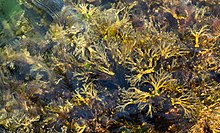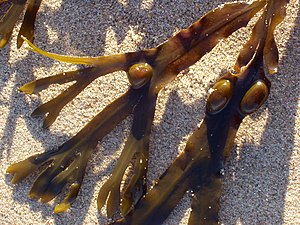bio.wikisort.org - Plant
Fucus vesiculosus, known by the common names bladder wrack, black tang, rockweed, sea grapes, bladder fucus, sea oak, cut weed, dyers fucus, red fucus and rock wrack, is a seaweed found on the coasts of the North Sea, the western Baltic Sea and the Atlantic and Pacific Oceans. It was the original source of iodine, discovered in 1811, and was used extensively to treat goitre, a swelling of the thyroid gland related to iodine deficiency.[1]
| Fucus vesiculosus | |
|---|---|
 | |
| Scientific classification | |
| Clade: | SAR |
| Phylum: | Ochrophyta |
| Class: | Phaeophyceae |
| Order: | Fucales |
| Family: | Fucaceae |
| Genus: | Fucus |
| Species: | F. vesiculosus |
| Binomial name | |
| Fucus vesiculosus | |

Description
The fronds of F. vesiculosus grow to 150 cm (59 in) long and 2.5 cm (1.0 in) wide and have a prominent midrib throughout. It is attached by a basal disc-shaped holdfast. It has almost spherical air bladders, which are usually paired one on either side of the mid-rib but may be absent in young plants. The margin is smooth and the frond is dichotomously branched. It is sometimes confused with Fucus spiralis with which it hybridises and is similar to Fucus serratus.[2][3]
Distribution
Fucus vesiculosus is a common large alga on the shores of the British Isles.[4] It has been recorded from the Atlantic shores of Europe, Northern Russia, the Baltic Sea, Greenland, Azores, Canary Islands, Morocco and Madeira.[5][6] It is also found on the Atlantic coast of North America from Ellesmere Island, Hudson Bay to North Carolina.[7]
Ecology
The species is especially common on sheltered shores from the middle littoral to lower intertidal levels.[7] It is rare on exposed shores, where any specimens may be short, stunted and without the air vesicles.[8] F. vesiculosus supports few colonial organisms but provides a canopy and shelter for the tube worm Spirorbis spirorbis, herbivorous isopods such as Idotea and surface-grazing snails such as Littorina obtusata.[2] Phlorotannins in Fucus vesiculosus act as chemical defenses against the marine herbivorous snail Littorina littorea.,[9] while galactolipids act as herbivore deterrents against the sea urchin Arbacia punctulata.[10] Methyl jasmonate may induce the phlorotannins production.[11] Fucophlorethol A is a type of phlorotannin found in F. vesiculosus.[12]
Biology
Plants of F. vesiculosus are dioecious. Gametes are generally released into the seawater under calm conditions, and the eggs are fertilized externally to produce a zygote.[2] Eggs are fertilized shortly after being released from the receptacle. A study on the coast of Maine showed that there was 100% fertilization at both exposed and sheltered sites.[2] Continuously submerged populations in the Baltic Sea are very responsive to turbulent conditions. High fertilization success is achieved because the gametes are released only when water velocities are low.[13]
Individuals of F. vesiculosus from the North Sea colonized the Baltic Sea less than 8 000 years ago. The event is paralleled by a switch from what seems to be obligate sexual recruitment to facultative asexual recruitment.[14] Asexual reproduction in Baltic Sea populations is accomplished by the production of adventitious branches that come loose and reattach to the bottom by the formation of rhizoids. Adventitious branches are present in thalli of F. vesiculosus in other areas too but asexual formation of new thalli has never been reported outside the Baltic Sea.[14][15]
Consumption
Fucus vesiculosus is sold as a nutritional supplement. Primary chemical constituents include mucilage, algin, mannitol, fucitol, beta-carotene, zeaxanthin, volatile oils, iodine, bromine, potassium and other minerals.[citation needed]
Adverse effects
Consumption of F. vesiculosus can cause platelet inhibition, which may potentiate the anticoagulant activity of warfarin (Coumadin).[16] It should be avoided before surgery.[16]
Some people may suffer an allergic reaction to the iodine in F. vesiculosus.[17]
See also
- Edible seaweed
- Iodine § Allergic reactions
References
- "Bladderwrack". WebMD. Retrieved 27 September 2018.
- Nicola White (2008). "Bladder wrack – Fucus vesiculosus". Marine Life Information Network. Archived from the original on 2012-04-02. Retrieved December 13, 2013.
- Newton, L. 1931. A Handbook of British Seaweeds. London. British Museum (Natural History)
- F. G. Hardy; M. D. Guiry (2003). A Check-list and Atlas of the Seaweeds of Britain and Ireland (PDF). London: British Phycological Society. ISBN 978-0-9527115-1-3.
- M. D. Guiry; Wendy Guiry (January 12, 2007). "Fucus vesiculosus Linnaeus". AlgaeBase. National University of Ireland, Galway. Retrieved April 22, 2012.
- Charlotta A. Nygård; Matthew J. Dring (2008). "Influence of salinity, temperature, dissolved inorganic carbon and nutrient concentration on the photosynthesis and growth of Fucus vesiculosus from the Baltic an Irish Seas". European Journal of Phycology. 43 (3): 253–262. doi:10.1080/09670260802172627.
- W. R. Taylor (1957). Marine Algae of the Northeastern Coast of North America. University of Michigan, Ann Arbor. ISBN 978-0-472-04904-2.
- C. S. Lobban; P. J. Harrison (1994). Seaweed Ecology and Physiology. Cambridge University Press, Cambridge. ISBN 978-0-521-40897-4.
- J. A. Geiselman; O. J. McConnell (1981). "Polyphenols in brown algae Fucus vesiculosus and Ascophyllum nodosum: chemical defenses against the marine herbivorous snail, Littorina littorea". Journal of Chemical Ecology. 7 (6): 1115–1133. doi:10.1007/BF00987632. PMID 24420835. S2CID 21550668.
- Michael S. Deal; Mark E. Hay; Dean Wilson; William Fenical (2003). "Galactolipids rather than phlorotannins as herbivore deterrents in the brown seaweed Fucus vesiculosus". Oecologia. 136 (1): 107–114. Bibcode:2003Oecol.136..107D. doi:10.1007/s00442-003-1242-3. PMID 12684854. S2CID 5821145.
- Thomas M. Arnold; Nancy M. Targett; Christopher E. Tanner; Walter I. Hatch; Kirstin E. Ferrari (2001). "Evidence for methyl jasmonate-induced phlorotannin production in Fucus vesiculosus (Phaeophyceae)". Journal of Phycology. 37 (6): 1026–1029. doi:10.1046/j.1529-8817.2001.01130.x. S2CID 84362547.
- Sabine Parys; Stefan Kehraus; Anja Krick; Karl-Werner Glombitza; Shmuel Carmeli; Karin Klimo; Clarissa Gerhäuser; Gabriele M. König (2010). "In vitro chemopreventive potential of fucophlorethols from the brown alga Fucus vesiculosus L. by anti-oxidant activity and inhibition of selected cytochrome P450 enzymes". Phytochemistry. 71 (2–3): 221–229. doi:10.1016/j.phytochem.2009.10.020. PMID 19954804.
- E. A. Serrao; G. Pearson; L. Kautsky; S. H. Brawley (1996). "Successful external fertilization in turbulent environments". Proceedings of the National Academy of Sciences. 93 (11): 5286–5290. Bibcode:1996PNAS...93.5286S. doi:10.1073/pnas.93.11.5286. PMC 39237. PMID 11607682.
- Tatarenkov, A.; Bergström, L.; Jönsson, R. B.; Serrão, E. A.; Kautsky, L.; Johannesson, K. (February 2005). "Intriguing asexual life in marginal populations of the brown seaweed Fucus vesiculosus". Molecular Ecology. 14 (2): 647–651. doi:10.1111/j.1365-294X.2005.02425.x. PMID 15660953. S2CID 16619196.
- Ardehed, Angelica; Johansson, Daniel; Sundqvist, Lisa; Schagerström, Ellen; Zagrodzka, Zuzanna; Kovaltchouk, Nikolaj A.; Bergström, Lena; Kautsky, Lena; Rafajlovic, Marina (2016-08-15). "Divergence within and among Seaweed Siblings (Fucus vesiculosus and F. radicans) in the Baltic Sea". PLOS ONE. 11 (8): e0161266. Bibcode:2016PLoSO..1161266A. doi:10.1371/journal.pone.0161266. PMC 4985153. PMID 27525655.
- "Herbs to Avoid Before Surgery". University of Texas, El Paso.
- "Bladderwrack". MedlinePlus. National Institutes of Health. Retrieved December 13, 2013.
External links
 Media related to Fucus vesiculosus at Wikimedia Commons
Media related to Fucus vesiculosus at Wikimedia Commons- Bunker, F. "Fucus vesiculosus Linnaeus Le Jolis". British Isles Seaweed Images. Archived from the original on 2012-03-24. Retrieved 2007-05-14.
- Guiry, M. D. "Fucus vesiculosus Linnaeus". North Atlantic Seaweeds. Archived from the original on 2010-10-07. Retrieved 2010-05-04.
- "Bladder wrack (Fucus vesiculosus)". ARKive. Archived from the original on 2011-08-23. Retrieved 2011-05-20.
- "Bladder wrack (Fucus vesiculosus)". Marine Life Information Network (MarLIN). Marine Biological Association of the UK. 2008.
- Guiry, M.D. (2017). Guiry, M.D.; Guiry, G.M. (eds.). "Fucus vesiculosus Linnaeus". AlgaeBase. Galway: National University of Ireland.
- Photos of Fucus vesiculosus on Sealife Collection
На других языках
- [en] Fucus vesiculosus
[es] Fucus vesiculosus
Fucus vesiculosus (sargazo vejigoso o sargazo vesiculoso) es un alga marina encontrada en las costas del mar del Norte, mar Báltico (costa oeste), océano Atlántico y Pacífico. Es un alga muy variable. Puede crecer hasta 1 m de largo y se la reconoce fácilmente por las vesículas llenas de gas nitrógeno, en pares a ambos lados de la nervadura central. Ascophyllum nodosum también tiene vesículas de aire, pero no están en pares sino en serie. Ambas especies son comunes en muchas playas gallegas o de las islas británicas.Другой контент может иметь иную лицензию. Перед использованием материалов сайта WikiSort.org внимательно изучите правила лицензирования конкретных элементов наполнения сайта.
WikiSort.org - проект по пересортировке и дополнению контента Википедии